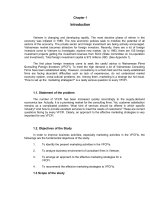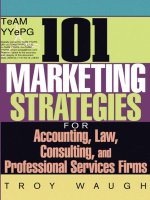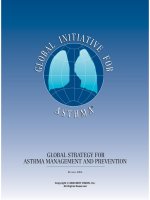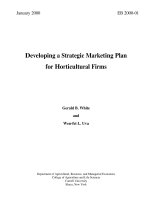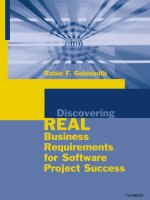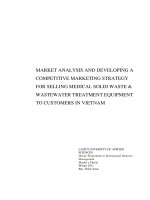successful marketing strategy for high-tech firms
Bạn đang xem bản rút gọn của tài liệu. Xem và tải ngay bản đầy đủ của tài liệu tại đây (17.62 MB, 243 trang )
TLFeBOOK
Discovering
Real Business Requirements for
Software Project Success
TLFeBOOK
For a listing of recent titles in the Artech House Computing Library,
turn to the back of this book.
TLFeBOOK
Discovering
Real Business Requirements for
Software Project Success
Robin F. Goldsmith
Artech House
Boston • London
www.artechhouse.com
TLFeBOOK
Library of Congress Cataloging-in-Publication Data
A catalog record for this book is available from the U.S. Library of Congress.
British Library Cataloguing in Publication Data
Goldsmith, Robin F.
Discovering real business requirements for software project success.
—(Artech House computing library)
1. Computer software – Developement 2. Computer software – Design – Methodology
3. Business – Computer programs
I. Title
005.1’2
Cover design by Igor Valdman
© 2004 ARTECH HOUSE, INC.
685 Canton Street
Norwood, MA 02062
The following are registered in the U.S. Patent and Trademark Office by Carnegie Mellon University: Capability
Maturity Model
, CMM
, and CMMI
.
Microsoft is a registered trademark of Microsoft Corporation.
Contents outline reprinted with permission from IEEE Std. 830-1998, “Recommended Practice for Software
Requirements,” Copyright 1998, by IEEE. The IEEE disclaims any responsibility or liability resulting from the
placement and use in the described manner.
All rights reserved. Printed and bound in the United States of America. No part of this book may be reproduced
or utilized in any form or by any means, electronic or mechanical, including photocopying, recording, or by any
information storage and retrieval system, without permission in writing from the publisher.
All terms mentioned in this book that are known to be trademarks or service marks have been appropriately
capitalized. Artech House cannot attest to the accuracy of this information. Use of a term in this book should not
be regarded as affecting the validity of any trademark or service mark.
International Standard Book Number: 1-58053-770-7
10987654321
TLFeBOOK
To my requirements:
Janice, Christian, and Tudor Noel,
who sometimes give me the business
TLFeBOOK
.
TLFeBOOK
Contents
1
2
Introduction . . . . . . . . . . . . . xv
How this book differs xvi
REAL requirements xviii
Applicability to various methodologies xviii
Objectives xix
What’s in it for you xx
Origins and structure xxi
What’s not in this book xxiii
Thanks xxiv
Who needs to know xix
References xxiv
Value up-front . . . . . . . . . . . . . 1
Preaching to the choir 1
Definition 2
Requirements impact 6
What it’s worth 9
Reconsidering iterative development 11
Is XP an eXception? 11
Mind traps that hinder improvement 12
Jolting awareness 13
Proactive Testing 14
CAT-Scan Approach 14
References 16
The “regular way” . . . . . . . . . . . 17
µUser review (test method #1) 18
vii
TLFeBOOK
viii Contents
3
4
µManagement review (test method #2) 18
µSupervisory review (test method #3) 19
µPeer review (test method #4) 19
µQA review (test method #5) 19
Exercise: Review requirements 20
Analysis of the regular way 21
Why requirements are hard to test 22
Other weaknesses of the regular way 23
Testing one’s own work 24
Strengthening the review 25
µUse formal technical review (test method #6) 26
Some key additional points about reviews 28
µPredefine topics, guidelines, and specifics to examine
(test method #7)
29
References 30
Real requirements . . . . . . . . . . . 31
Ann Analyst’s definition of requirements 31
µAre they business requirements? (test method #8) 33
“As is” versus “should be” 33
Format and contents 35
What versus how 36
Business versus system requirements 36
Automated teller machine example 38
Level of detail 40
A few more mythical distinctions 43
Who defines the requirements? 44
Make users responsible 45
Three necessary elements 46
How much is enough? 47
References 48
Evaluating requirements form . . . . . . . 51
µClarity (test method #9) 52
Form versus content 52
Two quick distinctions 53
µDeliverable whats (test method #10) 54
µTestable (test method #11) 55
µReviewable (test method #12) 56
µItemized (test method #13) 57
TLFeBOOK
ix Contents
5
6
7
µTraceable (test method #14) 57
µAmbiguity (test method #15) 58
µConsistent, known usage of terms (test method #16) 60
µIdentifies assumptions (test method #17) 61
µStated in the positive (test method #18) 61
µIdentifies objectives (test method #19) 61
µIdentifies major functions and limits (test method #20) 62
µIdentifies business rules (test method #21) 62
µAlternative consequences defined (test method #22) 63
µMagic words (test method #23) 63
µComplete (test method #24) 64
References 65
Discovering real requirements . . . . . . . 67
Why we say users don’t know what they want 68
Requirements gathering 69
Like a detective story 70
Focus on value 71
“Should be” model 72
Real and presumed processes 73
Some process pitfalls 75
Improving the process 76
References 77
Problem Pyramid . . . . . . . . . . . 79
The challenge 79
Problem Pyramid structure 80
Example: Reuse repository 82
Guidelines for evaluating the problem definition 83
Effects of applying the guidelines 84
Exercise: Prepare your own Problem Pyramid 85
Example: Social service software 86
Example: Web Site 88
Example: Opportunity 90
Exercise: Review your own Problem Pyramid 90
Applying the techniques . . . . . . . . . 91
Exercise: Review additional requirements 92
Analysis of Ann’s updated requirements 93
Identifying the real problem 93
TLFeBOOK
x Contents
8
9
ElecTech case Problem Pyramid 95
Data gathering . . . . . . . . . . . . 97
Why gather data? 97
Surveys and questionnaires 98
Literature searches 99
Reviewing documents 100
Prototyping 101
Focus groups 103
Joint application development 103
Observing operations 104
Learning to do the work 105
Interviewing 105
Interview techniques and tips 108
Advanced interview skills 110
Personality types 111
ElecTech case interviews 113
Exercise: Analyze real interviews 113
Gathering data in conjunction with interviews 122
References 123
Formats for analyzing requirements . . . . . 125
Data versus information 125
Exercise: Identifying what we don’t know 126
Sorting, summarizing, segmenting, and showing 127
Structuring business rule language 128
Cause-and-effect graphing 129
Decision trees 131
Decision tables 131
Entity relationship diagram 132
Data models 133
Organization chart 134
Responsibility matrix 135
Flowchart 136
Data flow diagram 138
Reference 140
Key to completeness . . . . . . . . . . 141
Importance of customer view 143
10
TLFeBOOK
xi Contents
11
12
Many manifestations of silos 143
Updating the ElecTech Problem Pyramid 145
Formats for documenting requirements . . . . 147
Generally agreed-upon contents 148
Generic unstructured individual requirements 149
IEEE Std. 830-1998 for Software Requirements Specifications 149
Pigeonholing 151
Nonfunctional requirements 151
Use cases 151
Seven guidelines for documenting hierarchical itemized deliverables 155
µHierarchical itemized business deliverable whats that contribute to
value (test method #25)
158
Exercise: Define top-level requirements 158
Scope that doesn’t creep 161
High-level conceptual design 161
Iterative requirements negotiation without analysis paralysis 162
Estimating time and effort to implement the requirements 164
Detailed requirements 164
References 166
Finding overlooked requirements . . . . . . 167
µUsers, customers, and stakeholders (test method #26) 169
Exercise: Identify stakeholders 170
µQuality dimension: Quality of design (test method #27) 170
µQuality dimension: Quality of conformance (test method #28) 170
µQuality dimension: Quality of performance (test method #29) 171
Strawman technique 171
µAddressing quality factors (test method #30) 173
µAligning strategic, management, and operational needs
(test method #31)
174
µTechnology requirements versus design (test method #32) 175
µIncluding commonly overlooked deliverables (test method #33) 176
µInterfaces with other systems (test method #34) 176
µThird-party access and auditing (test method #35) 177
µConformance to laws and regulations (test method #36) 177
Checking requirements accuracy and
completeness
. . . . . . . . . . . . 179
µImportance and criticality (test method #37) 179
13
TLFeBOOK
xii Contents
14
µClarifying application feature quality requirements
(test method #38)
180
µGuidelines and conventions (test method #39) 182
µEngineering standards (test method #40) 182
µBalancing conflicting requirements trade-offs (test method #41) 186
µWork out business rules (test method #42) 186
µDetermine rules regarding corrections (test method #43) 187
µIdentify data retention and purging (test method #44) 187
µIdentify historical data archiving and access (test method #45) 187
µMap to manual procedures (test method #46) 187
µAnticipate parameters of likely changes (test method #47) 188
µReview test cases (test method #48) 188
µPrototype (test method #49) 189
µSimulate workload performance (test method #50) 189
µRequirements walkthroughs (test method #51) 190
µJoint application development (test method #52) 190
µDefining acceptance criteria (test method #53) 191
µMatch against an independent mini definition (test method #54) 192
µMatch against an independent “canned” definition
(test method #55)
192
µIndependent expert validation (test method #56) 193
Exercise: Your independent expert review 193
µTwo independent reviews (test method #57) 193
Measuring proof of the pudding . . . . . . 195
µCost/benefit analysis (test method #58) 195
µChallenge cost and benefit estimates (test method #59) 197
µDefine system requirements (test method #60) 198
µDefine use cases for product usage (test method #61) 198
µTrace addressing of business requirements (test method #62) 198
µMonitor requirements changes (test method #63) 199
µMonitor subsequent defects (test method #64) 200
Summary 200
Appendix: Summary of 21+ ways to test
requirements
. . . . . . . . . . . . 203
The “regular way” 203
Foundation techniques 203
Topics, guidelines, and specifics to test requirements form 203
Topics, guidelines, and specifics to reveal overlooked requirements 204
TLFeBOOK
Contents xiii
Topics, guidelines, and specifics to test requirements accuracy and completeness 204
Topics, guidelines, and specifics to test requirements overall 205
About the Author . . . . . . . . . . . 207
Index . . . . . . . . . . . . . . . 209
TLFeBOOK
.
TLFeBOOK
Introduction
“It’s not right.”
“It’s what you said you wanted.”
“Well, it’s still not right.”
Every system developer I’ve ever met has experienced some similar frustrat
-
ing dialog with his or her user. Those of us who are charged with
developing systems—including analysts, programmers, testers, and their
managers—continue not to get it right for those who depend on systems to
help them do the business’ work.
Our problems start with the requirements, what must be delivered to provide
value. The requirements set the tone and parameters for a system that is to
be developed. A system isn’t likely to be better than its requirements. When
we don’t get the requirements right, getting the system right becomes much
more challenging.
Routinely, projects proceed with only partial requirements, the degree of
which seldom is recognized at the time. Progress is uneven—the more and
wider diversions from “right,” the less adequate the requirements are. Con-
sequently, much of project effort consists of course-correcting adjustment
iterations that often also identify new and changed requirements, again
with varying adequacy. This continual addition and changing of require
-
ments generally is called “requirements creep” or “scope creep
1
.” It’s enor
-
mously expensive because it usually entails throwing out and redoing
previously completed work.
In information technology (IT), which I’m using synonymously with
“systems” to embrace development and support of software and/or hard
-
ware solutions, for internal and/or external use, the virtually universally
accepted conventional wisdom holds that such creep is inevitable and
unavoidable. Developers generally feel they reasonably do know the right
requirements as they begin implementation, but they also believe ongoing
market, business, and legal/regulatory changes mean the requirements are
no longer right by the time they finish. Almost all developers further agree
1. While attending a presentation by the author at the System Management/Applications of Software
Measurement SM/ASM 2002 Conference, fellow speaker Dale Emery asked, “Who is this requirements creep,
and why is he on my projects?” I’ll bet he’s on your projects too.
xv
TLFeBOOK
xvi Introduction
that requirements creep still more as users (applying the term broadly to
include all sources of business requirements, not just those who personally
use a system) seem to change their minds, which is attributed mainly to the
“fact” that “users don’t know what they want.”
As an industry, we’ve been at system development for 50 years and still
don’t get it right. Let me suggest maybe we just don’t get it, period. Our cus
-
tomary approaches don’t work very well, and they need a lot more help
than the mere tweaking usually offered as advice.
The conventional wisdom above and many other similarly accepted
truths often are not helping us. In fact, they are quite likely to be hurting
us, in ways that are all the more insidiously damaging, because we follow
them under the illusion we’re applying wisdom. I’m sure most conven
-
tional wisdom probably does start with some measure of truth and with the
best of intentions, but then it’s prone to getting out of hand. We tend to
miss some of the story, often the important part. It’s so much easier just to
accept generalizations and reassurances that relieve us of responsibility for
our results.
Yes, requirements change, but they don’t have to change nearly to the extent
that we’ve grown content with. Some methodologies even treat requirements
change as sort of a virtue, often making it a self-fulfilling prophecy and
masking its true cost. We can do a lot better—maybe not perfection, but a lot
better—but not by continuing to think and do things the same old ways. Require-
ments creep and projects fail, not because of some cosmic inevitability that
we’re powerless to confront, but mainly because of the practices that we
routinely and usually intentionally apply.
We receive the results we create. As an industry, we keep doing the same
things and expecting a different result. That’s the definition of insanity.
This book presents a different way of thinking about and defining
requirements. It challenges some conventional wisdom, and furthermore it
challenges the reader to take more active responsibility for changing their
results.
✖
Warning
Some readers may find these challenges troubling and may be tempted to reject
out of hand my suggestion that some customary methods may not be so effective
as they presume. Many colleagues, clients, and others hearing these ideas for the
first time express similar reservations.
Those who are open to new ways of looking
at familiar things, hearing out the ideas in full, and experiencing them in action (as
we’ll do in this book) then often say they wish they’d known and used these ideas
all along.
How this book differs
This book presents numerous practical techniques woven together within a
more effective way to approach requirements where “It’s not right” is not
inevitable:
TLFeBOOK
xvii How this book differs
1. This book is about business requirements. Business requirements are
the REAL requirements that the systems we create are meant to sat
-
isfy. As an industry, we tend to delude ourselves into thinking the
products we build are what the business requires. The REAL reason for
much of software project difficulty is the failure of our products’ requirements
to meet the business requirements. Such failure indeed is practically
inevitable because our supposed conventional wisdom and good
practices generally distract us from adequately identifying the REAL,
business requirements. Requirements creep and projects overrun as
we inefficiently go back into finally identifying the REAL, business
requirements we didn’t know to identify earlier.
2. This book emphasizes how to discover what the REAL business
requirements are—their content or substance. This is perhaps the
hardest part of system development and gets little attention com
-
pared to the amount spent on the form and storage of requirements.
These other “requirements management” and “requirements engi
-
neering” concerns are important, and we’ll address them after we’ve
addressed the more important matters of getting the content right.
To aid the reader in discovering the REAL requirements content, this
book introduces a very powerful tool called a Problem Pyramid
that helps avoid common requirements pitfalls
2
.
3. This book describes more than 21 practical and effective ways to test
that the requirements have been defined appropriately. Testing as
we’re using the term in this book includes static test methods, such as
reviews and inspections. Twenty-one ways may sound overwhelm-
ing or possibly nitpicking, but I think you’ll find these tests workable
and powerful aids to complement discovery. To make it clear when
the book is discussing ways to test requirements, each of the 21+
ways is designated by a µ star symbol. The more ways you use, the
more requirements issues you detect when they are easiest to fix. We
address not only the commonly relied-upon but surprisingly weak
ways that test requirements’ form, but also additional less well-
known, more powerful ways to identify overlooked requirements
and check the accuracy of content.
4. This book places responsibility on those of us charged with discovering
requirements to do a much better job, rather than falling back on the
tired old excuses. We truly can identify REAL requirements much
more accurately, completely, and early than conventional wisdom
would have us believe.
2. Throughout this book you’ll see several terms designated with trademarks on their initial mentions in the text.
These are trademarks owned by me and my company, Go Pro Management, Inc. The purpose of a trademark is
to identify a specific unusual use of a term which is proprietary to the trademark holder. These are valuable
pieces of intellectual property which the law protects against misappropriation. You are welcome to use the
terms, just please include the trademark symbol and proper attribution. Thank you.
TLFeBOOK
xviii Introduction
REAL requirements
This book uses the term “REAL” (in all capitals solely for emphasis and not
as an acronym) with regard to requirements. By REAL, we’re embracing
two important related meanings. The first is one that developers generally
can identify with. It’s common for developers to get requirements from
users, only to discover that the user actually wanted something different. In
my experience, developers routinely refer to the user’s redefined require
-
ments as the “real requirements.”
The second meaning for REAL is more subtle and less likely to be one
that people recognize consciously. Quite simply, a user seldom actually
requires the system that the developer provides. Rather, the system is a
means for meeting the user’s REAL requirements for accomplishing their
business purposes. This book is about discovering these frequently unarticu
-
lated business requirements, so that developers in fact can provide the
proper systems to meet them.
Applicability to various methodologies
As I write this book, the methodological fad du jour is “agile development.”
Not surprisingly, therefore, a reviewer asked how this book fits with it.
This book is not about agile development but fits well with it. The book
also fits well with other approaches. The need to know the business requirements
is universal and is not a function of job title, development methods, programming
languages, hardware/software platform environments, application involved, nature
of user, external visibility of implementation, importance or size of the problem/
opportunity.
Moreover, this book’s approach is not heavy on formality. Rather, I
emphasize content. I do not believe in busywork for its own sake. That is
not to say, though, that I am against writing things down, which alas I fear is
some people’s definition of “agile.” Overattention to form can be a real
problem and is not limited to requirements. For example, some prominent
software testing gurus actively advocate not spending time writing test
plans, because they feel the time would be better spent executing tests to
hunt down bugs in the system.
I agree, to an extent, and preface my Proactive Testing seminars with,
“Write no more than is helpful—and no less.” This book adopts the same
philosophy. It emphasizes practical methods that real people can imple
-
ment; and it provides a breadth of methods that facilitate scaling to the size
and shape of one’s own situation.
The most well-known agile method, eXtreme Programming (XP),
actively enlists users in creating user stories, which are a format for briefly
documenting the requirements for the code that will be programmed [1]. I
salute XP and any other technique which actually does promote meaningful
user involvement. The XP community seems pretty convinced that user sto
-
ries are the business requirements. Just because they originate from the user
doesn’t mean user stories, or any other requirements, necessarily are the
TLFeBOOK
xix How this book differs
REAL, business requirements. User stories, and other touted techniques,
will become even more valuable when used in conjunction with this book’s
approaches and methods for discovering business requirements.
Objectives
After reading this book, readers should be able to:
◗
Effectively discover business requirements at both high and detailed
levels.
◗
Distinguish the nature, role, and importance of business requirements
from system requirements and use cases.
◗
Apply the Problem Pyramid tool to guide reliable identification of the
REAL problem/opportunity and business requirements.
◗
Use interviewing and other well-known practices more effectively to
better discover relevant data concerning requirements.
◗
Selectively apply more than 21 ways to test the accuracy and adequacy
of business requirements from perspectives of:
◗
Assessing suitability of form;
◗
Identifying overlooked requirements;
◗
Evaluating substance/content.
◗
Enlist appropriate models and formats for analyzing and understanding
the requirements data.
◗
Apply 7 guidelines for documenting and communicating the business
requirements.
◗
Differentiate the scope of the business requirements from the scope of
implementation.
◗
Manage the process of iteratively discovering, testing, and negotiating
business requirements without analysis paralysis.
In short, I want you to be able to experience the “You understand us bet
-
ter than we do” type of feedback which I’ve been fortunate to receive many
times from clients in a variety of businesses.
Who needs to know
This book is for:
◗
Analysts, project managers, consultants, developers, and others who
are involved with identifying requirements.
◗
Quality assurance, testing, auditing, and process improvement profes
-
sionals who have, or would want to have, occasion to assure the REAL
requirements have been defined accurately and completely.
TLFeBOOK
xx Introduction
◗
Users and business managers, including marketing staff, who seek an
explanation for why the technical people repeatedly fail to understand
what the business’ requirements really are and need ways to be sure
they are defined appropriately.
◗
Instructors and students, whether in universities or professional train
-
ing situations, who need to learn these important lessons before join
-
ing the above ranks.
Caveat: No methods work by themselves. Your skills applying the methods
and knowledge of your business, as well as system development, greatly
influence the value you’ll get from these or any methods. Practice and review
for improvement are essential for developing proficiency.
What’s in it for you
Organizations that learn to identify business requirements well can gain an insur
-
mountable advantage over competitors that persist in getting conventional results
with conventional approaches. This is not just my perception. Recently, the
heads of both IBM and Hewlett-Packard have announced independently
that success today in the information systems industry demands primary
attention to understanding the needs of the customer, in other words, the
business’ requirements.
Isn’t this old news? We’ve been talking for decades about how necessary
it is for IT to align with the business. Surely alignment demands first that IT
understand what the business needs—its requirements. Aren’t we already
doing it?
If anyone in IT is understanding business needs, it would be the out
-
sourcing vendors, who after all command premium pay in part because
of being perceived as more businesslike. Yet, in a recent issue of CIO,
Mohanbir Sawhney writes, “Before a vendor starts designing your solution,
make sure it understands your real problem”[2]. I’d guess the author,
along with most of the rest of us, has encountered solutions-for-pay that
didn’t meet the REAL business requirements because they hadn’t been
understood.
I’d further suggest that IT trails business in general in this realm, and
business in general still seems to be having trouble. Just for example, let me
cite two articles from the March 2003 Quality Progress (the current issue as I
write this), the magazine of the American Society for Quality. One article is
titled, “The Shift to Customer Focus”[3]. Shift! I thought total quality man
-
agement (TQM) made that shift ten years ago. Apparently not.
Even more telling is what Editor Debbie Phillips-Donaldson writes: “One
member of a conference panel commented that with ISO 9000:2000, this is
the first time companies actually have to worry about their customers’
needs [4].” It takes the new ISO 9000 standard to get companies to care
about customers’ needs?
TLFeBOOK
xxi How this book differs
Origins and structure
This book is based upon more than 35 years of hands-on experience per
-
forming, managing, and advising business and systems professionals on the
development, acquisition, testing, support, and use of systems to meet busi
-
ness needs. I’ve captured those lessons in the various seminars I present
regularly for business and systems professionals. The seminars have pro
-
vided a valuable means for organizing, testing, and refining the concepts
and techniques.
The structure of the book draws primarily upon two complementary
seminars that I conduct: a two-day Defining and Managing User Requirements
[5] and a one-day 21 Ways to Test Business Requirements [6], (which is also
the first day of a two-day seminar entitled Testing Early in the Life Cycle
[7]). My two-day Managing Systems Projects with Credibility [8] seminar also
presents the methods described in this book for defining scope that doesn’t
creep.
As with the seminars, this book reinforces concepts and techniques by
applying them all to the same real case situation. The case comes from a
company whose name (which I will not reveal—I don’t reveal any of my cli
-
ents’ names) is synonymous with world-class excellence. Even the best
organizations have trouble defining business requirements well.
Whereas my individual seminars deal separately with discovery and
with testing, in this book we’ll intertwine discovery and testing techniques.
Here is how the chapters proceed. Chapter 1 sets the stage with fundamen-
tal information about requirements and their challenges, including why it is
hard to test that requirements are right. Chapter 2 presents the case’s initial
requirements definition and the regular ways that organizations conven-
tionally rely on to test requirements, but which are weaker than usually is
realized.
Chapter 3 explores why business requirements are the REAL require
-
ments and differentiates them from other uses of the term requirements.
Chapter 4 describes a number of ways to test requirements form, which rep
-
resents the main type of testing techniques ordinarily portrayed in the
requirements literature.
Then we get to the heart of the book. Chapter 5 describes methods for
discovering the business requirements content, and Chapter 6 introduces
the powerful Problem Pyramid tool that Chapter 7 applies to the case.
Chapter 8 explains data-gathering techniques and uses the case situation to
work through realistic examples of interviewing dos and don’ts.
Chapter 9 examines modeling formats that serve both discovery and
testing roles to help understand the requirements better. Chapter 10 identi
-
fies the keys to making sure the requirements are dealing with the complete
story.
Only after discovering the REAL content, not until Chapter 11, do
we get to documenting the business requirements. This chapter further
describes a multilevel iterative approach that can drastically reduce
scope creep while also avoiding analysis paralysis. Chapters 12 and 13,
TLFeBOOK
xxii Introduction
respectively, subject these seemingly suitable requirements to two other
very powerful and too-seldom used categories of testing that reveal over
-
looked requirements and content inaccuracies. Chapter 14 concludes with
methods and tools for managing the requirements process and controlling
changes.
Some authors offer advice in the Introduction on how to jump about the
book and skip chapters selectively. I’m not going to do that. Instead, I
encourage reading this book in sequence from front to back for the follow
-
ing reasons:
◗
Each chapter builds on the prior chapters. They’re not isolated
standalone pieces. The place to be selective is later in deciding which
methods to apply and to what extent, not which ones to read about.
◗
The usual rationale for skipping chapters is that they contain only infor
-
mation that experienced readers already know. Well, this book was neces
-
sary because I’ve found the industry doesn’t know the ideas in it, but often
presumes that it does. Moreover, I think one of the main reasons our
industry doesn’t get better at requirements is because many of us
misjudge how well we already do. It’s exactly the material that an
experienced person thinks he knows that may be most important to
read in the (I think you’ll find different) context I present it.
◗
If you’re in a skipping mode, you may be most prone to skip past the
business case and related exercises, since very often the cases and
exercises presented in books seem superficial and contrived. I don’t
use the case merely to illustrate foregone conclusions, which often
initially seem so obvious, but then are hard for readers to replicate in
their own projects. This book is different. The business case has real
substance. Working through the case exercises is the best way I know to gain
true useful understanding not only of the concepts and techniques, but also of
the thought processes needed to apply them, that often are difficult because they
probably represent new ways of thinking.
You’ll learn a lot more by doing the exercises than just by reading about
them in the textual analysis. Trying the methods with the case’s fact situa
-
tion at the suggested times, and stumbling sometimes, makes the methods
come alive and be much more meaningful than merely passively reading
about them. If you do try the methods, you may stumble at first, because
they are unfamiliar and often hard. Some people don’t like trying things
they’re not good at right away, but I’ve never found a substitute for trying,
making mistakes, and then most importantly analyzing, correcting, and
learning from them.
I’ve honed these concepts and exercises with thousands of experienced
business and systems professionals throughout the world from many differ
-
ent industries, roles, and backgrounds. I believe they form a representative
sample of common experiences with systems projects and requirements.
Therefore, throughout the book I draw upon reactions, behaviors, and
TLFeBOOK
xxiii How this book differs
comments from clients and seminar participants with the assumption that
they will be similar to those of most readers. Consequently, the analysis in
the book probably will identify most of the issues you encounter. If you
bump into something that I’ve missed, or have any other comments or
suggestions about the book, please let me know at www.gopromanage
-
ment.com. That’s how I continually improve.
What’s not in this book
This is not theory, which is the opposite of practical. The purpose of this book
is to present to practitioners a set of useful concepts and techniques that
have evolved through extensive practical systems development and acquisi
-
tion experience, which I’ve been able to refine within the context of highly
interactive seminars. In addition to specific techniques, I do emphasize
understanding how and why the techniques work. I find that understanding
the concepts underlying the practical techniques is key to adapting the tech
-
niques to one’s own situation.
This book is not thick. On the premise that a book is more useful if it’s
actually read, and that the likelihood of being read is inversely proportional
to its girth, this book is relatively short. Thus, for example, I’ve skipped the
seemingly obligatory prosaic opening that goes on at length about how
important information systems are.
This book is not attempting to survey the literature on requirements or provide
extensive footnote references. If you want them, a number of other books
include summaries of many prior requirements writings. While I certainly
give credit to sources of ideas where I can, I’m only giving citations for ideas
that I actually took from a particular identifiable source or represent good
sources of added information. I apologize in advance for not always know
-
ing where I heard or read something, perhaps years ago (which may be an
affliction of the practitioner as contrasted with an academic, or maybe it’s
just a sign of growing ripe).
A number of other books offer valuable information relevant to some
aspects of requirements. In fact, since 1999 a veritable plethora seems to be
coming on the scene after a long period with relatively few books about
requirements. I developed the concepts and approaches in this book before
most of the other books were written, and I admit back then I was busier
discovering clients’ REAL requirements than reading those few books that
did exist on the subject.
I indeed have read many of the other writings and have not found any
which address my key emphases on discovering and testing the content of
REAL business requirements. Some of the specific techniques I describe,
though, indeed are well known and may appear in other writings. I don’t
feel compelled to acknowledge every possible place which may describe
them too.
Finally, this book does not debate with previous writings. I endeavor to
point out when I am presenting approaches which differ from those found
TLFeBOOK
xxiv Introduction
in other books, but I’m not going to dwell on what the other books say, and
my reasons for disagreeing should be apparent.
Thanks
This book is about getting things right and has a hearty respect for testing.
So too do I have a hearty respect and gratitude for the colleagues, clients,
and seminar participants who have been kind enough to test my work and
provide excellent valuable feedback to help me get the ideas first, and then
secondly the book, right.
I chose to solicit advance feedback from a small select group of col
-
leagues whose opinions I value. None of them is the author of a book on
requirements, because some colleague authors have suggested that any
author of a related book inevitably would approach a review of this book
from the standpoint that it should be the same as theirs. I’m writing this
book to say something different, ideas I think need to be said. Colleagues
Tom Belanger, Ross Collard, Carol Dekkers, Bob Galen, Dorothy Graham,
John Lisle, Gary Mogyorodi, Rebecca Staton-Reinstein, and Linda Westfall:
Thank you all for your invaluable advice. Thank you also to Tim Pitts and
Tiina Ruonamaa of Artech House Books for their patience, support, and
assistance.
References
[1] Beck, K., eXtreme Programming Explained, Boston, MA: Addison-Wesley, 2000.
[2] Sawhney, M., “The Problem with Solutions,” CIO, February 15, 2003, pp. 42–44.
[3] Lindborg, H., “The Shift to Customer Focus,” Quality Progress, March 2003,
pp. 84–85.
[4] Phillips-Donaldson, D., “Pathos and Progress,” Quality Progress, March 2003, p. 6.
[5] Goldsmith, R. F., Defining and Managing User Requirements, Needham, MA: Go Pro
Management, Inc., 2003.
[6] Goldsmith, R. F., 21 Ways to Test Business Requirements, Needham, MA: Go Pro
Management, Inc., 2003.
[7] Goldsmith, R. F., Testing Early in the Life Cycle, Needham, MA: Go Pro
Management, Inc., 2003.
[8] Goldsmith, R. F., Managing Systems Projects with Credibility, Needham, MA: Go Pro
Management, Inc., 2003.
TLFeBOOK


